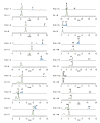Characterization of a NRPS-like Protein from Pestalotiopsis fici for Aldehyde Generation
- PMID: 36294566
- PMCID: PMC9605436
- DOI: 10.3390/jof8101001
Characterization of a NRPS-like Protein from Pestalotiopsis fici for Aldehyde Generation
Abstract
Nonribosomal peptide synthetase (NRPS)-like enzymes containing A-T-R domain architecture are also known as carboxylate reductases (CARs) for aldehyde generation. To identify new members of CARs, we established a virtual library containing 84 fungal CARs distributed in seven distinct clades by genome mining and phylogenetic analysis. Nine CARs, including PnlA from Pestalotiopsis fici and eight known CARs, were clustered in clade VI and proposed to catalyze the reduction of nonreducing polyketide synthase (NR-PKS)-derived aryl carboxylic acids. The recombinant protein PnlA was overproduced and purified to apparent homogeneity from Saccharomyces cerevisiae. In vitro enzyme assays of PnlA with 28 different benzoic acid derivatives (1-28) revealed the corresponding aldehyde formation in 14 cases (1-14). Comparison of conversion yields indicated the high preference of PnlA toward 3,5-dimethylorsellinic acid (DMOA, 4) and vanillic acid (10). A specificity-conferring code Q355 in PnlA was postulated by sequence alignment with the known CARs in clade VI. Our study provides an updated virtual library of fungal CAR enzymes and expands the biocatalytic selectivity of CARs.
Keywords: NRPS-like enzyme; Pestalotiopsis fici; aldehyde generation; benzoic acid derivatives; fungal carboxylate reductase (CAR).
Conflict of interest statement
The authors declare no conflict of interest. The funders had no role in the design of the study; in the collection, analyses, or interpretation of data; in the writing of the manuscript, or in the decision to publish the results.
Figures





Similar articles
-
Biosynthesis of LL-Z1272β: Discovery of a New Member of NRPS-like Enzymes for Aryl-Aldehyde Formation.Chembiochem. 2016 May 17;17(10):904-7. doi: 10.1002/cbic.201600087. Epub 2016 Apr 9. Chembiochem. 2016. PMID: 26972702
-
Characterization of Carboxylic Acid Reductases as Enzymes in the Toolbox for Synthetic Chemistry.ChemCatChem. 2017 Mar 20;9(6):1005-1017. doi: 10.1002/cctc.201601249. Epub 2017 Feb 14. ChemCatChem. 2017. PMID: 28450969 Free PMC article.
-
Four distinct types of E.C. 1.2.1.30 enzymes can catalyze the reduction of carboxylic acids to aldehydes.J Biotechnol. 2017 Sep 10;257:222-232. doi: 10.1016/j.jbiotec.2017.02.014. Epub 2017 Feb 20. J Biotechnol. 2017. PMID: 28223183
-
Protein engineering for bioreduction of carboxylic acids.J Biotechnol. 2019 Sep 10;303:53-64. doi: 10.1016/j.jbiotec.2019.07.001. Epub 2019 Jul 17. J Biotechnol. 2019. PMID: 31325477 Review.
-
Carboxylic acid reductase enzymes (CARs).Curr Opin Chem Biol. 2018 Apr;43:23-29. doi: 10.1016/j.cbpa.2017.10.006. Epub 2017 Nov 9. Curr Opin Chem Biol. 2018. PMID: 29127833 Review.
Cited by
-
Recent advances on Pestalotiopsis genus: chemistry, biological activities, structure-activity relationship, and biosynthesis.Arch Pharm Res. 2023 Jun;46(6):449-499. doi: 10.1007/s12272-023-01453-2. Epub 2023 Jun 30. Arch Pharm Res. 2023. PMID: 37389739 Review.
-
Identification and Reconstitution of the First Two Enzymatic Steps for the Biosynthesis of Bioactive Meroterpenoids from Hericium erinaceus (Lion's Mane Mushroom).Molecules. 2024 Nov 26;29(23):5576. doi: 10.3390/molecules29235576. Molecules. 2024. PMID: 39683734 Free PMC article.
References
-
- Neethu K., Karthik L., Li Z. Nonribosomally and ribosomally synthesized bioactive peptides (NRPS and RiPPs) from Actinobacteria. In: Karthik L., editor. Actinobacteria: Microbiology to Synthetic Biology. Springer Nature; Singapore: 2022. pp. 87–99.
-
- Zhu J., Chen W., Li Y.Y., Deng J.J., Zhu D.Y., Duan J., Liu Y., Shi G.Y., Xie C., Wang H.X., et al. Identification and catalytic characterization of a nonribosomal peptide synthetase-like (NRPS-like) enzyme involved in the biosynthesis of echosides from Streptomyces sp. LZ35. Gene. 2014;546:352–358. doi: 10.1016/j.gene.2014.05.053. - DOI - PubMed
Grants and funding
- 2020YFA0907800/National Key Research and Development Program of China
- 31861133004/National Natural Science Foundation of China
- ZDBS-LY-SM016/Key Research Program of Frontier Sciences, Chinese Academy of Sciences
- KFJ-BRP-009-005/Biological Resources Program, Chinese Academy of Sciences
- YJ20200201/China Postdoctoral Science Foundation
LinkOut - more resources
Full Text Sources
Miscellaneous

